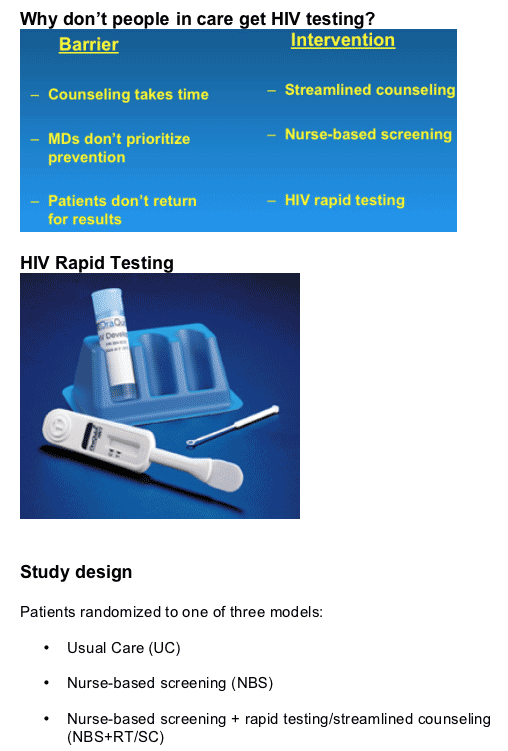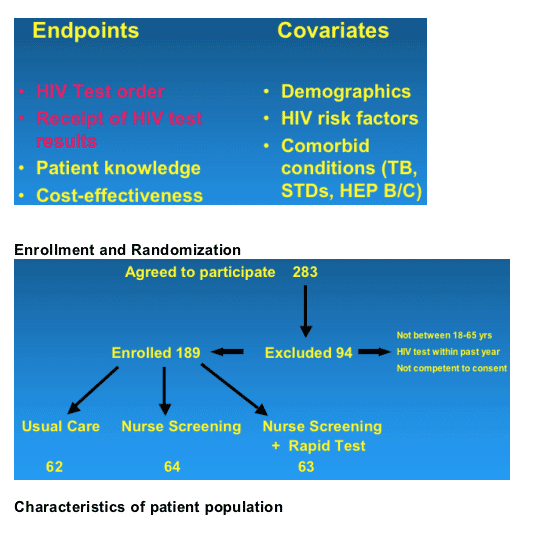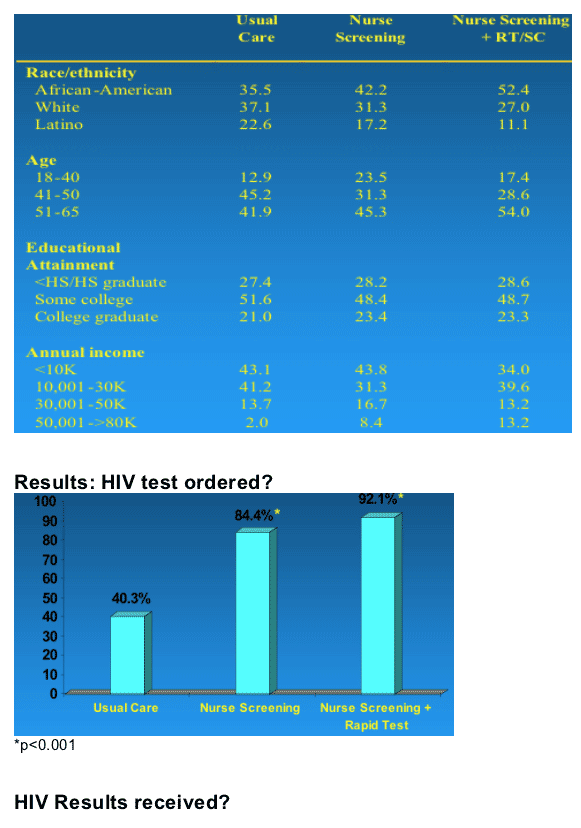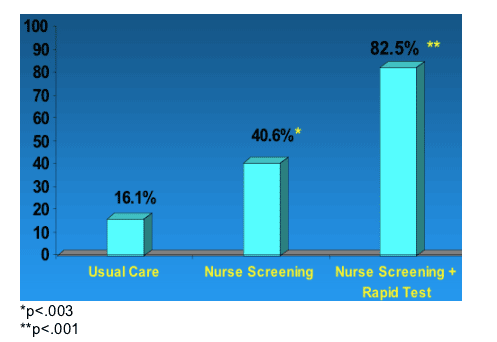 |
 |
 |
| |
HIV Rapid Testing Has Arrived
|
| |
| |
Reported by Jules Levin
XVI Intl AIDS Conference Toronto Aug 2006
Rapid tests mean more learn HIV status: study
Fri Aug 18, 2006 10:02 AM BST140
The VA presented a study of rapid testing at the Late Breaker oral session on Thursday in Toronto. See Conference Abstract & slides below.
TORONTO (Reuters Health) - Rapid HIV tests lead to more people getti
ng tested and receiving their results, according to a study by the US Department of Veterans Affairs presented at the 16th International AIDS Conference.
Both traditional testing and newer rapid tests were likely to result in higher screening rates for HIV, according to the study. But patients who received rapid testing were much more likely to learn their results.
HIV testing is cost-effective, but testing rates for at-risk populations in the U.S. are low. "Even people who are in care and are seeing their doctor on a regular basis, and are identified as being at risk for HIV infection, are not being tested at nearly the rate that they should be," said Dr. Henry Anaya, who presented the study.
Testing is important because people tend to reduce their risk behaviors when they know their HIV status, Anaya said.
Patients waiting for an appointment at VA primary/urgent care clinics in Los Angeles were randomly split into three testing groups. The patients were all between 18 and 65 years of age and were unaware of their HIV status. None had been tested in the past year.
The first group of patients was prompted to ask their doctor for an HIV test during their appointment; the second group was referred to a nurse for traditional HIV testing; and the third group was also referred to a nurse but these patients received the rapid HIV test.
Traditional HIV testing involves two appointments -- one for testing, and another some days later, to receive the results and counseling. Rapid tests involve an oral swab or a finger stick and results can be available in as little as 20 minutes.
Forty-one percent of the patients told to ask their physician for a test actually did, and 41 percent of those tested received their results. Double the patients who were referred to a nurse for testing actually did take the HIV test. Eighty-four percent of those referred for traditional testing received it, as did 93 percent of those in the rapid test group.
But many more patients in the rapid test group actually received their results -- 90 percent compared to 52 percent for those who had to return to get their results and counseling.
"The magnitude and direction of these results surprised even us," Anaya said.
The results show that referring patients for testing is effective in both cases, but rapid testing resulted in nearly double the patients ultimately learning their HIV status.
The testing project is currently being used in an outreach effort directed at homeless veterans with the Los Angeles County, and the hope is for it to be expanded nationally across the Department of Veterans Affairs, Anaya said.
Conference Abstract
Improving HIV Screening with Rapid Testing and Streamlined Counseling
Anaya H.1, Asch S.2
1United States Department of Veteran''s Affairs, Los Angeles, United States, 2US Department of Veteran's Affairs, Los Angeles, United States
Objectives: HIV testing is cost-effective in unselected general medical populations, yet rates of testing among those at-risk remain below optimal, even among those with regular primary care. The specific aims of this project are:
- To determine whether nurse-based referral for traditional HIV counseling/testing will improve screening rates compared to current testing procedures.
- To determine whether nurse-based rapid testing with streamlined counseling improves screening rates more than nurse-based referral for traditional testing and counseling alone.
Methods:A parallel-group, controlled study was conducted in the primary/urgent care clinics of the Los Angeles VA. Eligibility was based on same-day appointment; age (18-65); no HIV test in past year; unknown HIV status. One hundred sixty six patients were randomized to one of three screening models: Model A: patients urged to discuss testing with physician (control). Model B: nurses offered traditional counseling/testing. Model C; nurses offered streamlined counseling/rapid testing. Interventions were performed by nurses in addition to regular clinic duties.
Results/findings: Model A: 22 patients (40.7%) had test ordered; Model B: 48 (84.2%) had test ordered; Model C: 51 (92.7%) had test ordered. Of 22 patients in Model A with a test order, 9 (40.9%) received results; of 48 patients in Model B with test order, 25 (52.1%) received results; of 51 patients in Model C with test order, 46 (90.2%) received results.
Conclusions: Results show that both interventional models will likely result in higher screening rates than traditional HIV testing models in primary care.
Impact Statements: HIV rapid testing has been shown to be effective in conveying results. Increased rates of testing could lead to earlier disease identification, increased treatment and reduced morbidity/mortality. Reduced counseling intensity might free staff resources. As the VA is the largest HIV care provider in the US, it would be beneficial for policymakers to consider implementing rapid testing regularly.
Conference slides:
Improving HIV Screening with
Rapid Testing
and Streamlined Counseling
Henry D. Anaya, PhD
Steven M. Asch, MD MPH, Tuyen Hoang, PhD, Joya F. Golden, BA, Matthew B. Goetz, MD, Allen Gifford, MD, Candice Bowman, PhD RN
Most people worldwide unaware of their HIV status
- 45 million infected with HIV worldwide
- 95% unaware of HIV-positive status
- Those aware of HIV status lower HIV-risk behaviors
- Even those in care don't get HIV tested




Conclusions
HIV Test order
- Nurse Screening increased test order compared to Usual Care;
- Slight increase w/ addition of
- Rapid Test/Streamlined Counseling
Receipt of HIV results
- Nurse Screening increased receipt of results compared to Usual Care;
- Significant increase w/ addition of
- Rapid Test/Streamlined Counseling
Implications
Expansion into nationwide VA delivery system
Basis for other outreach efforts
Integration into similar healthcare systems
|
| |
|
 |
 |
|
|